005: The Blue Roof Inn
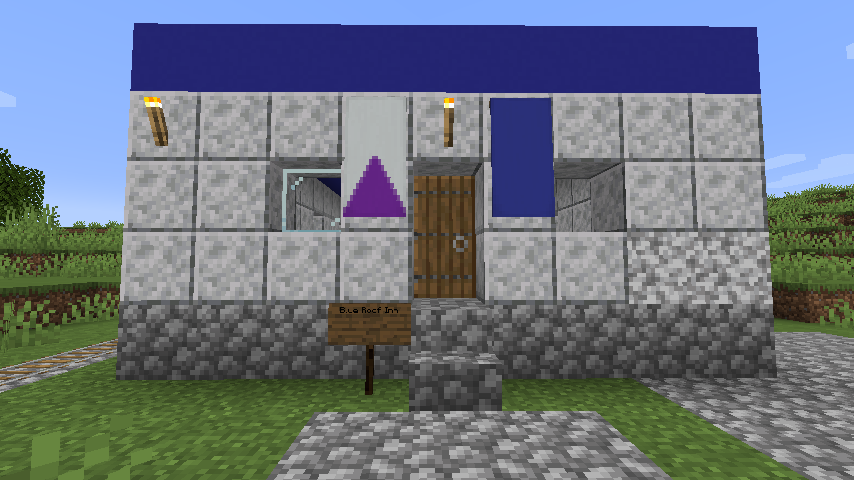
Screenshot: A Minecraft waystation, built on a 1 block high solid cobblestone foundation, 9 blocks wide, walls of polished diorite 3 blocks high, blue concrete roof. A plain blue banner hangs to the right of the door at the center, on the other side a white banner with a purple triangle at the base. A sign by the steps identifies the building as the Blue Roof Inn.
This was one of the early waystations, built after Cliffside and the Pink Palace (named after the pink granite used for the walls) but before the Purple Palace (named for the décor, after I got a nice supply of purple dye). I chose diorite for the walls so they would contrast with the rich blue of the roof. If colored concrete wasn’t such a pain to make, I’d use it a lot more. I may yet do a Rainbow Palace. But that’s another article for another time. The regular diorite on the corner is where I had to patch after a creeper went off right outside the house while I was inside working. Thought they had to have a path to you to arm themselves. Asshole took out the corner of the building, broke a double-wide chest and sprayed items all over, I was sorting out stuff for a while because I had to grab everything I could, stuff it into the nearest surviving chest, then grab another load, trying to make sure I collected everything before it despawned. Annoyed me considerably. I have, ass an aside, noticed what appears to be an increase in creepers as I have played this world longer. I wonder if it’s a response to my lighting up and pacifying so much of the game world, a sort of antibody reaction to the colonialist irritant carving up the land.
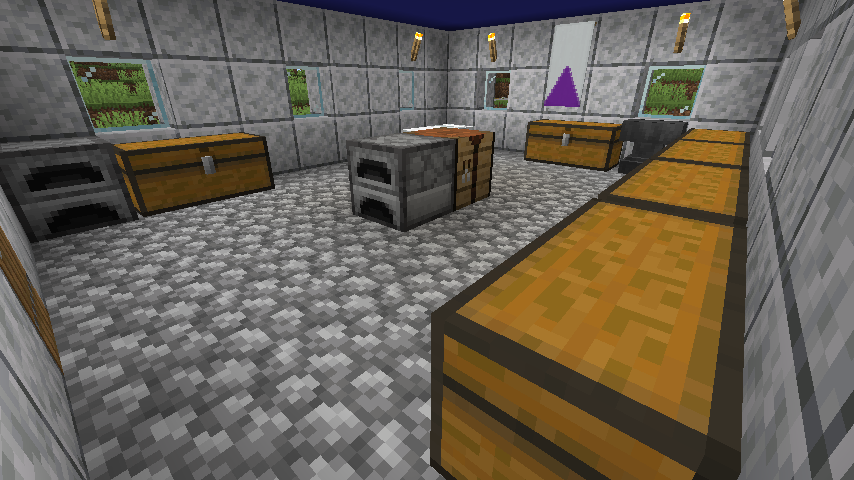
Screenshot: Interior of the waystation, from the front right corner, chests along the near wall, a furnace and crafting table out in the middle of the room, another furnace and a chest over in the front left corner, an anvil and another chest along the back wall, and a bed just visible past the crafting table in the back left corner. The imperial banner hangs in the center of the back wall, where it’s directly in front of you on the far wall when you walk in the door. A number of torches around the top of the wall light the room.
The Blue Roof Inn has a somewhat odd interior layout because I was trying to make use of the central space. It didn’t pan out, which is why I went back to the smaller, more compact layout with everything up against the walls. Having the crafting table out in the middle of the floor should have made using it easier, with everything within easy reach, but instead it was just in the way.
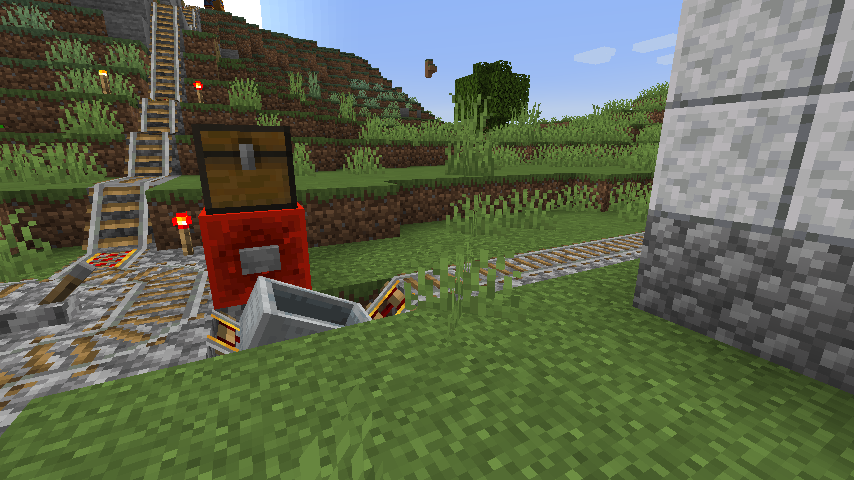
Screenshot: the Western Railway leaving the station and going up a large hill in a series of stairsteps, on a narrow-roadbed cobblestone foundation. In the center, the end of another rail line, going north, has a launcher with a chest sitting atop the redstone block. The rail line runs out of sight past the corner of the station.
This is an unnamed line that runs up to a mining camp at the edge of a chasm, roughly even with the north village, the one that ended up deserted and that I’ve been disassembling for materials. It’s a fairly long trip to get up there on foot. Maintaining grade with the narrow-roadbed construction went through a lot of cobblestone and produced a Great Wall effect, as I never went to a skyway and maintained a solid foundation the whole way. It did clean out a lot of cobblestone I had laying around. I should save further commentary for an article about that line and the mining camp.
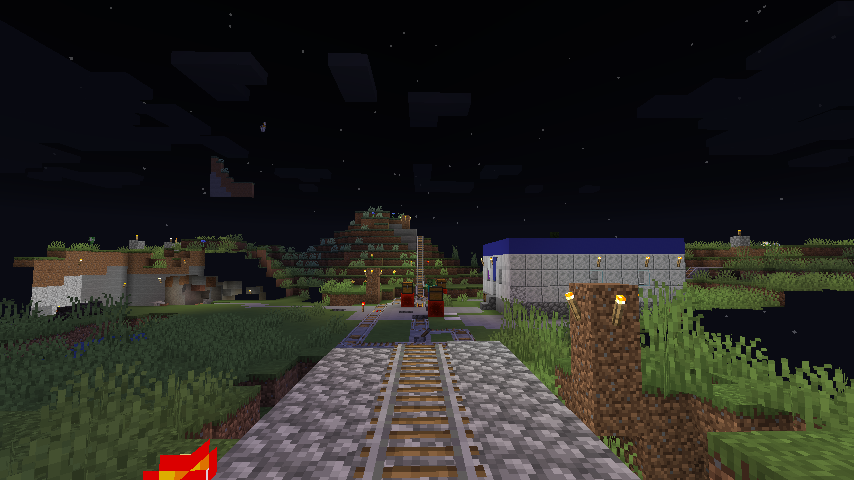
Screenshot: The Blue Roof Inn seen from a nearby hill, looking west down the railway line with the station on the right. In the background, the previously mentioned stairstep line goes up the mountain. The railway is lit by dirt pylons, generally three blocks high, with torches on all four sides of the top block. To the left, across the railway from the station, an abandoned attempt at strip-mining stands, still well lit with torches at various points down its walls. The land to the immediate right hasn’t entirely loaded, and the night sky can be seen where grass ought to be.
This shot is included partly for context, to show the Blue Roof Inn and its setting, and partly because of the stripmine across the road. This is something I felt needed a comment. I found an abandoned mineshaft, one of those cobweb and spider infested mineworks with the bracing that’s only decorative just enough of the time to lull you into a false sense of security. After wandering around the place trying to explore it in a methodical fashion, I got tired of it, and decided to stripmine the damn thing and tear it down one block level at a time. I got a fair distance down before I realized I was going to spend hours of game time whacking away at this project and burning through a lot of iron in the form of pickaxes for nowhere near enough gain and walked away from it. This leaves the question though, why? Largely a matter of efficiency. Stripmining is only possible because of heavy machinery and explosives. You just can’t do it with manual labor. We created the tools, and people decided to put them to a highly destructive use, and I have to wonder where the loop went out of scope. At what point did we make stripmining both physically and economically feasible? In the world of Minecraft, it’s brutally inefficient. There’s simply not ever going to be sufficient reward to compensate for the investment in time and materials. I see this as a good thing. The game system has modeled a world where ecologically destructive mining isn’t worth the effort. In the real world, we overcame the inefficiencies and went at it hammer and tongs. The only satisfaction here being that we did it most to ourselves, the nations that invented it. Getting all that heavy machinery into the deep jungle is just not worth the effort. Let it remain that way.
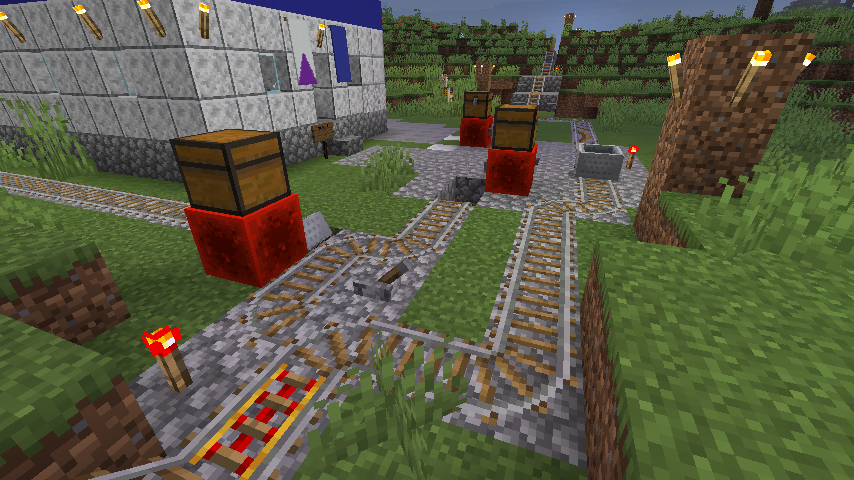
Screenshot: A tangle of rails, launchers, switches, redstone boxes with chests atop, pylons with torches, and to the left the Blue Roof Inn.
The switching out front is awkward because it was retrofitted. This was originally a Roman Road, and I had to do some tinkering to shoehorn in a pair of minecart launchers, switches, and a bypass loop. I’m also not happy about the mountain ascent. A tunnel would have been more efficient. However, I didn’t start doing tunnels for rail until the Grand Concourse. The Western, being narrow gauge, has a few hill cuts, where I went through instead of over, and more leveling to grade later in its course, but here I attempted to convert the existing footpath. Lesson learned. The requirements for footpaths and railways are different, as is what makes them efficient.
And that concludes this nickel tour. Please exit through the gift shop.